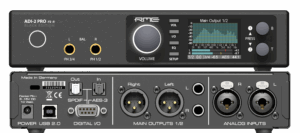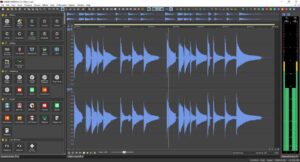Nerd-torial: The Mother Earth Radio Vinyl Recording Workflow – Why we do (almost) everything right
Welcome, dear audio nerds and sound aesthetes! At Mother Earth Radio, we value sound quality that breathes the spirit of music and touches the soul. But to achieve this, it takes more than just good records and a record player. It takes a sophisticated, technical workflow that gets the most out of every vinyl groove.
In this nerd-torial, we take you on a deep dive into our vinyl recording and editing process. We explain why we made certain decisions and why our current workflow is very close to the ideal – even if we can’t do everything “perfectly”.
Step 1: The supreme discipline – vinyl recording with the RME ADI-2 Pro FS
It all starts with the analog source: our beloved records. At the heart of this step is the RME ADI-2 Pro FS. This high-end AD/DA converter is known for its precise and transparent conversion.

We record in 768 kHz and 32-bit integer. “Wait a minute”, one or two nerds may now interject, “why not 32-bit floating point?” That’s a perfectly valid question! The RME ADI-2 Pro FS converts internally with 32-bit integer. This means that it offers a fixed dynamic range of a gigantic 190 dB. This is far more than even the most dynamic record can ever deliver and also far beyond what our ears can perceive.
The point is: when recording vinyl, where we can control the analog level via the preamplifier, the risk of digital clipping is virtually eliminated with the ADI-2 Pro FS – provided that we level out cleanly. We use the extremely high resolution of the converter to precisely capture every detail of the vinyl. The discussion about 32-bit float in recording is often more relevant in uncontrollable live environments where unexpected level peaks can occur. For our carefully controlled vinyl process, 32-bit integer is absolutely tops at this point.
Step 2: The magic of post-processing – Sound Forge Pro 15 and 64 Bit Float

After recording in 768 kHz and 32-bit integer, the raw file ends up in our digital processing lab: Magix Sound Forge Pro 15. And here comes the real highlight that makes our workflow so powerful!
As soon as the file is loaded into Sound Forge, it is converted into the 64-bit floating point format for internal processing. And this is where the aforementioned advantage of floating point comes into its own!
What does 64-bit float mean? Imagine your audio data is no longer on a fixed ladder (as with Integer), but on a ladder that dynamically adjusts its rung spacing. The internal 64-bit float processing offers a virtually infinite dynamic range. This is where the “non-clipping” takes place. No matter how loud or quiet a signal gets internally, or how many calculations are performed – there is no more digital clipping.
This is crucial for our processing steps:
- DC Offset Removal: The removal of unwanted DC components in the signal.
- Declicking: The sensitive removal of crackling and pops, which can unfortunately be part of the vinyl experience.
- Resampling (multiple times): We go through several resampling processes from 768 kHz up to 192 kHz. Each of these steps requires complex recalculations of the audio data.
- Pitch shifting: Another operation that requires immense computing power and precision.
All these operations take place in the 64-bit float environment. The result: minimal rounding errors, maximum precision and absolutely no digital clipping during the entire processing chain. The integrity of the audio signal is preserved to the maximum.
Step 3: Finishing – volume according to EBU R128 and dithering
Once all the processing steps in the high-precision 64-bit float domain have been completed, it is time for the final refinement and export.
- Volume normalization to EBU R128 (-23 dBFS): We adjust the overall volume of the audio to the EBU R128 standard, more precisely to -23 LUFS (Loudness Units Full Scale). This standard is crucial for consistent playback across different platforms and ensures a pleasant listening experience. Thanks to floating point processing, we can make this adjustment precisely without losing information or clipping, even if the original level was significantly higher.
- POWR dithering to 24 bit: The last step before export is dithering. Here we reduce the internal 64-bit float precision to our target format of 24-bit integer. Now the layman might ask: “Won’t everything you did before with float be ‘perdu’ again?” The clear answer: No, absolutely not!Imagine you have created a perfect work of art in a huge studio (64-bit float). All colors, brushstrokes and details have been applied with the utmost care and precision. At the end, this masterpiece is placed in a perfectly fitting, high-quality frame (24-bit). The quality of the previous work is retained and is visible in the final result. Dithering is a mathematical process that deliberately adds a low, barely audible noise to mask quantization errors when scaling down the bit depth, thus ensuring the best possible quality in the reduced format. The POWR (Psychoacoustically Optimized Wordlength Reduction) dithering that we use is particularly optimized for human hearing.
- Encoding as FLAC: Finally, the file is encoded as FLAC (Free Lossless Audio Codec). FLAC is a lossless compression format. This means that the audio quality we have carefully worked out up to this point is fully preserved, while the file size is reduced.
Why is this workflow “ultimate” (or at least damn close to it)?
Mother Earth Radio’s workflow is a combination of high-quality hardware and intelligent software processing.
- High-resolution recording: The RME ADI-2 Pro FS delivers an extremely precise digital image of the vinyl source.
- Error-free internal processing: Sound Forge Pro 15’s 64-bit floating point engine virtually eliminates all digital clipping risks and ensures maximum precision in all processing steps. This is the decisive advantage that goes beyond the pure bit depth of the source file.
- Quality preservation: Careful dithering practice ensures that the high quality of the internal processing is optimally transferred to the final 24-bit format.
- Lossless distribution: FLAC guarantees that the listener gets exactly the quality we created in the studio.
Although we don’t record directly in 32-bit float (which isn’t necessary in our vinyl digitization setup), we take advantage of floating point arithmetic where it matters most: throughout the entire processing chain. This makes our process one of the most advanced and quality-oriented workflows for record archiving and distribution.
We hope this nerd-torial has given you a deeper insight into how we work. Stay tuned for more technical insights and of course great music on Mother Earth Radio!
Florian Reiterer is an audio engineer and musician with a passion for high-resolution audio. He founded Mother Earth Radio to explore and deliver the best possible listening experience.
…see full Bio

Leave a Reply
You must be logged in to post a comment.